This letter was written by Erasmus Norcross Jencks (1821-18xx), while he was a student at Brown University in Providence, Rhode Island. Jencks became an American Baptist missionary.
Being ordained to the ministry, he was appointed missionary to the Chinese by the American Baptist Missionary Union (ABMU). He left New York in the ship Cohota on 29 June 1846, with his wife, the Revs. W. Dean, S. C. Clopton, and George Pearcy, with their wives. They arrived at Macao on 6 October 1846. Jencks proceeded from Hongkong to Bangkok, Siam, in the same year. There he made rapid progress with the language, but soon afterwards Mrs. Jencks’ failing health compelled them to leave the field. They left Bangkok in November 1847, returned to China via Singapore, and embarked at Whampoa on 12 April 1848 in the Valparaiso for the United States. Mrs. Jencks died at sea. Erasmus Jencks remarried and engaged in ministerial labors in the United States, having dissolved his connection with the ABMU.
In 1860 he was a minister in Illinois; in the 1880 census he is listed as a Co. Surveyor in Lone Tree Township, Clay Co., Iowa.
E. N. Jencks married Caroline Baldwin on 6 February 1846. She was the daughter of the Rev. Daniel Baldwin, of Milford, Connecticut. [Note: Wylie gives her name as Susan Baldwin.] She died at sea on 27 June 1848, in latitude 32° 10′ South, longitude 14° East, and her remains were committed to the deep the following day.
TRANSCRIPTION
Addressed to Miss Caroline Baldwin, New Preston, Connecticut
Brown University, Providence, Rhode Island
Wednesday Evening, September 13, 1843My Dearest Caroline,
Again I am at home and comfortably situated, and frequently now do I unconsciously permit my thoughts to wander back to you & he many happy seasons which we have enjoyed together. I have heard & read a great deal about the happiness of the period of childhood but I must confess that my happiest period has been that in which I have enjoyed your society.
But now perhaps you will expect to hear how I arrived here and my adventures by the way. They were very common-place, but here they are. I arrived at N. York Thursday evening about two hours too late for the Providence boats & so went up into the city & procured a lodging. After breakfast the next morning, I commenced my tour through the city as I was not to leave till 5 o’clock P.M.
After some ineffectual attempts to find the residence of Mr. Toohey so as to see Norman, I visited the room of the A & F. Bible Society in the new church in Broom St. of which you have seen an engraving in the report of last year as well as in the Monurial. The engraving is very true. I knew the church at once & was not obliged to make any enquiries. I have not room to say much about the rooms now; they are very convenient but he society is yet young & they are not full. I saw many different translations of the scriptures & my attention was particularly attracted by Mr. [Adonirum] Judson’s Burman Bible, as well as the table on which he translated it, & which was presented to the society by someone who brought it from India. It is quite small & old. Before I left the rooms, they presented me with a nice German Testament which was translated, you know, by “Dr. Martin Luther.”
In the next place I called on Rev. Mr. Perkins and introduced myself as one who had just come from his old friends in Connecticut. He was glad to hear from Elder Baldwin & family, and requested me to remember him when I wrote. He had just returned from a long visit in the country in which he attended the Commencement at Hamilton. There was a Dr. Hooper there from Charleston, S.C., who had just placed a son at the Inst. at Hamilton.
After leaving Mr. Perkins, I returned to Broadway and explored the city from end to end. In the first place I went to the upper end of Broadway where it appears to be terminated by Union Park which is a very pleasant little grove full of trees, but they are yet young and appear to have been recently set out. There is also a very pretty little pond with a fountain in the middle of it which keeps the air cool and it was very refreshing to me for the day was very warm.
Then I turned back to find the other end of the street and I found that it was not only a “broad way” but a long way too. The next place that I stopped at was the “Apollo” where they manufacture & keep all kinds of statuary. As I consider myself somewhat an admirer of the fine arts, I enjoyed it very much. Yet the collection here is not as large as the one in Boston which I mentioned to you, tho’ they have here some few superior specimens of the art.
I called at the Library next which is truly great, both in respect to the books themselves & the building which contains them. I next visited the Astor House, the City Hall, & the American Institute, but I did not find much to interest me in either place — perhaps because I had so little time to examine them. At the Astor House I was some disgusted and pained to see so many young men step up to the bar & drink of their punch & suck their “Mint Julap” for they have to draw it into their mouths thro’ a long straw or reed, and it does look so silly and boyish that it does seem that gentlemen could not condescend to do it. ¹
The City Hall is an immense building and is situated in the midst of the park — a large & beautiful common on the east side of Broadway. The floors are of marble & laid in mosaic work. I also visited several churches. The Broadway Tabernacle — the largest house in the city — was fortunately open; as they were repairing the organ. I went in and counted the pews & set down the no. but I cannot find it now. It looks much the worse for wear. The orchestra is behind the pulpit & the wall overhead is ornamented with stucco painting. What! Have I got to the end? but never mind it. If you will turn back this way, I will show you a new way to write double. But I am always full of new inventions & I do not know but I shall get a patent for this for among other numerous advantages one dot will answer for two &c. Well what next? I do not know but I shall tire you out but as I have commenced my story, I will finish it.
The next church I visited was St. Paul’s — Episcopalian. Gen. Richard Montgomery — the much lamented young hero who fell at the attack on Quebec lies interred under the tower of the house & in front — about five feet from the ground is the tomb-stone which is beautifully sculptured with many embossed ornaments representing coats of arms &c. Emmet, the Irish orator, has also a splendid monument just south of the church & on a line with the front. The monument is a plain marble pillar shaped exactly like the monument of Bunker Hill and about 40 or 50 feet high, as I should think. They call it a “Censtaple.” This church — St. Paul’s — is the “Cathedral.” The Catholic Cathedral is called St. Patrick. I saw that. It is larger but does not stand in so public a part of the city. I could not go into either of them. But they are now building a new church belonging to the Episcopal’s which they call Trinity Church which will far surpass all others in the city. I went into it & thought, while wondering at its massive architecture, of the line of [William Cullen] Bryant, “To gather & roll back,” &c. But I will not trouble you with any more of my N. York notes for I can scarcely read what I have written myself. But if you will turn over the next page, I will show you another way of writing double. My red ink is very pale but perhaps that plan will go better than this.
Last week was commencement week and a very good time of it we had too. The exercises commenced on Tuesday afternoon when the Philermenian & United Brother Societies had their anniversaries. An oration was pronounced by Esq. Thomas of Worcester and a poem by Esq. Jencks of this city, who was formerly Tutor in College. Oh! I forgot to mention that on Tuesday morning the Alumni Association had their meeting when a most interesting oration was delivered by Judge [John] Pitman, L.L.D. — one of the oldest graduates of the college. He gave its history from the first commencement up to the present time & his delivery was animated & his language excellent. The oration before the Society by Mr. Thomas was rich in thought and full of bright ideas. The poem was not so good as Lovell’s last year.
On Wednesday was the commencement where everything came off in the purest elegance & highest style. The valedictory was pronounced by Divine of Newport, the Salutary by Day of Westfeld, Mass., the classical oration by Croswell of Falmouth, Mass., & the Philosophical Oration by Bartlett of Worcester. On Wednesday evening, the Phi Beta Kappa Society had its anniversary when an oration was delivered by Judge Job Durfee. We were disappointed about our orator in the Missionary Society so that we had no meeting — George B. Ide of Philadelphia who was to speak being sick.
But I must now bring my very correct letter to a close. My health now is very good but I have scarcely yet recovered the buoyant elasticity of mind & limb which I had before that terrible “Tyler Grip” took me. For a day or two last week I was quite unwell for I worked too hard, I suppose, moving furniture & setting up my stove. I still room alone and have not got things nearly to my mind. I wish you could step in here and see how comfortable I am. I have a fine stove with 3 cylinders and having sold the desk which I had last year, I have now purchased a secretary of the olden time having four large drawers below and a large leaf turning down covered with green hide for a writing table on which I am penning this with plenty of small drawers before me all labeled off — one literary & another Theological & Poetical & Mathematical & Classical & Historical &c. besides a great number of pigeon holes labelled as follows: sewing, sealing, writing, medicinal confectionary, &c. &c. Above the secretary is a large bookcase full of books which I love so much &c. I have got me a rocking chair too with a stuffed back. Indeed, I cannot tell you all my comforts but bid you to imagine them & imagine that I am as happy as I can be away from you.
Your own most affectionate, — Erasmus
¹ Drinking Mint Julep’s through a straw kept the cold drink at the correct temperature. The earliest straws were reeds of rye grass but the flavor of the rye often ruined the drink. Modern day straws eventually replaced these reeds.

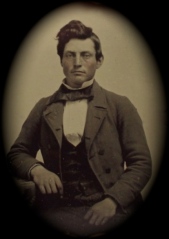
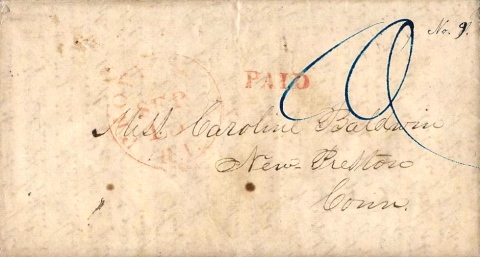
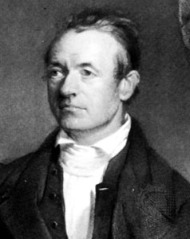
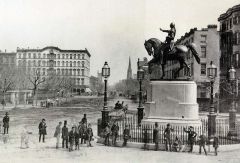
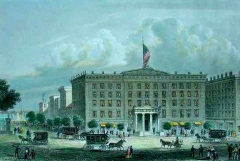
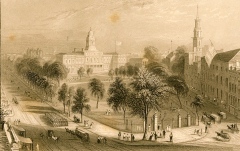
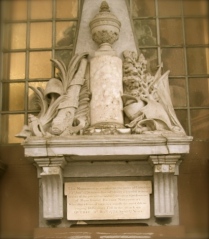




February 18th, 2016 at 10:21 pm
Thank you so much, Griff, for sparing and transcribing that piece of Jencks and Baldwin history. If I ever come across portraits of the young lovers, I will be sure to send them your way.
August 21st, 2016 at 7:41 pm
Thank you for that wonderful entry. I am a descendent of Joseph Jencks, Colonial Governor of Rhode Island appointed by King George II of England.
It is always interesting to read about the Jencks family history.
Douglas Jencks-Palm Beach, Florida USA